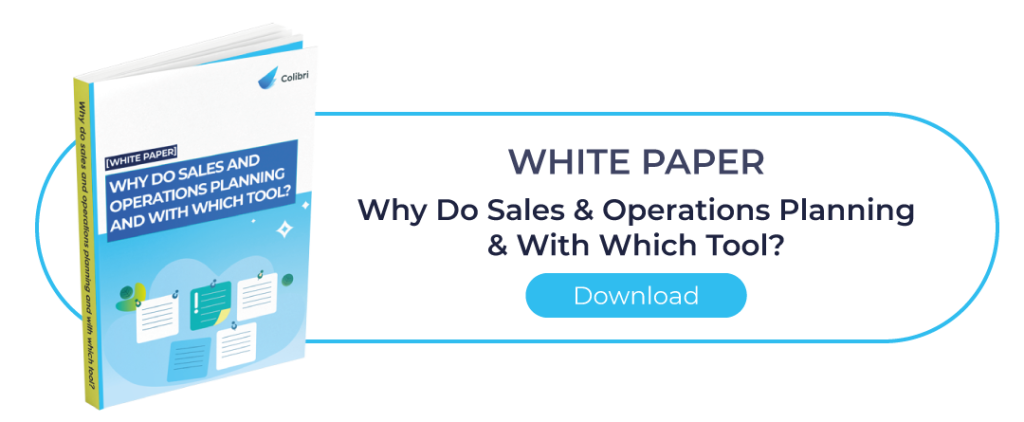In a constantly changing market, establishing an S&OP process is becoming necessary for companies. All departments must work together to absorb variations and achieve the set targets. However, setting up an S&OP process is not self-evident. For it to be effective, certain good practices must be respected. Here are 7 of them that you can implement in your company today.
S&OP process: a fundamental role
First, it is essential to understand the S&OP process or industrial and commercial plan (ICP). This process consists of rigorous planning of the company’s activities so that actions are consistent with demand, sales targets, and available resources. This planning must include all the company’s departments: supply chain, marketing, finance, human resources, etc. Established over the medium term, this strategy makes it possible to coordinate decisions and anticipate variations. Stock management is facilitated, flows are accelerated, delivery delays are avoided, and internal conflicts are defused, with an obvious impact on performance.
These numerous advantages make the S&OP process a fundamental element for more and more companies. However, a few good practices must be followed to take advantage of all the benefits of S&OP!
7 good practices for an effective S&OP process
By avoiding certain mistakes and adopting good habits, your company can implement an S&OP process that ensures productivity and sustainability. Here are 7 that you can quickly implement.
1. A collaborative process
The S&OP process is holistic. This means that it concerns all departments of a company. S&OP cannot be reduced to supply chain planning. Without integrating the other departments into the project, malfunctions and conflicts cannot be avoided. S&OP must therefore be collaborative. CFO, sales, marketing, HR: each decision must be taken in light of the needs and resources of each department. Better global visibility will enable the implementation of optimised actions tailored to the reality of your company. In addition, information will flow more transparently through your team, and conflicts will be defused before they arise.
2. Monthly meetings
Because unforeseen events – internal or external – are to be expected, the S&OP process must be updated regularly. To do this, holding dedicated monthly meetings is a good practice. A representative from each department can bring up any problems to find solutions together. An S&OP officer can be appointed to lead these meetings. They will also ensure that all departments attach importance to the project and follow good practices.
3. Sufficient time
These short-term meetings should be used to steer a medium-term strategy. While it is difficult to anticipate the inevitable variations over a long period, it is possible to study which scenario is the most likely. Regular updates will allow one to adapt as one goes along. Indeed, to reap the full benefits, your process needs to take place over a long period. It is advisable to plan it over 12 to 24 months. This allows time for the different teams to adapt to the established organisation. One of the objectives of S&OP is to avoid working in a hurry. However, an S&OP process designed over a few months would have the opposite effect.
4. A good level of detail
The granularity of the S&OP process is a thorny issue for companies. Globally, your method can be applied either to product families or the products themselves. Obviously, by detailing the item, the process becomes much more complex. However, some items require different resources from the rest of their product family. There is, therefore, no general best practice. As far as possible, focus on a product family strategy. But if your departments tell you that it is impossible to work this way, you will have to adapt. The monthly meetings will allow you to find a consensus.

5. Unified strategic assumptions
One of the pitfalls of implementing an S&OP process is that it can be too broad. You can’t do everything! So, ask yourself what you want to do. For example, establishing unified strategic assumptions means focusing planning efforts on the most important areas of your business. For some companies, the main issue will be team management. For others, it may be inventory management, outsourcing, financial management or marketing strategy. Focusing on the essentials will enable you to make informed and effective decisions.
6. A link between strategic and operational plans
Establishing a clear and relevant link between the strategic and operational plans is one of the main challenges of S&OP planning. Suppose you establish a strategy that does not take operational planning into account. In that case, you will not achieve your objectives, create conflict between your different departments and risk not being able to meet your customers’ requirements. It is imperative that Demand Planning, Strategic Planning and Supply Planning are implemented together and in a transparent way. Without this, inconsistent decisions will be made, and you will face easily avoidable problems.
7. An S&OP planning tool
Setting up an efficient S&OP process is complex. This is especially true if you do not have a more modern tool than Excel to organise it. A good practice is to equip your company with an S&OP planning tool. There are all kinds on the market… make sure you choose the right one. The selection of an S&OP planning tool is based on three criteria:
- Your budget.
- The maturity of your team.
- The urgency of the project.
You must provide easy-to-understand tools to get your departments on board and start the process quickly.
Adopting the correct practices and choosing the proper planning tool allows your company to implement an efficient S&OP easily and quickly. You will have a reliable decision support system, and your teams will be able to gain peace of mind.
Colibri can help you in this process. Our cloud-based Sales & Operations Planning software, with its many modules, can be adapted to your company, whatever the sector of activity. Ergonomic and easy to use, Colibri is deployed in 3 months in 90% of the companies that adopt it. Do you have a project? Do you have a question? Contact us now!






